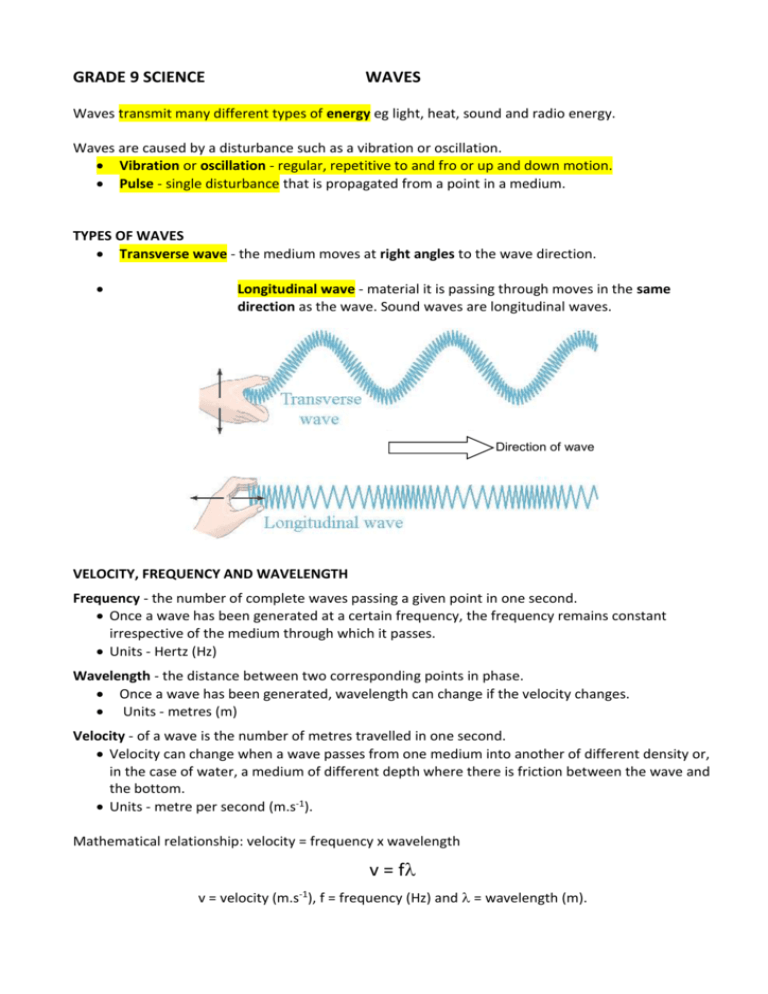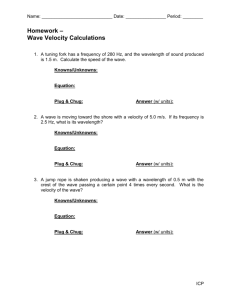types of waves
advertisement

GRADE 9 SCIENCE WAVES Waves transmit many different types of energy eg light, heat, sound and radio energy. Waves are caused by a disturbance such as a vibration or oscillation. Vibration or oscillation - regular, repetitive to and fro or up and down motion. Pulse - single disturbance that is propagated from a point in a medium. TYPES OF WAVES Transverse wave - the medium moves at right angles to the wave direction. Longitudinal wave - material it is passing through moves in the same direction as the wave. Sound waves are longitudinal waves. Direction of wave VELOCITY, FREQUENCY AND WAVELENGTH Frequency - the number of complete waves passing a given point in one second. Once a wave has been generated at a certain frequency, the frequency remains constant irrespective of the medium through which it passes. Units - Hertz (Hz) Wavelength - the distance between two corresponding points in phase. Once a wave has been generated, wavelength can change if the velocity changes. Units - metres (m) Velocity - of a wave is the number of metres travelled in one second. Velocity can change when a wave passes from one medium into another of different density or, in the case of water, a medium of different depth where there is friction between the wave and the bottom. Units - metre per second (m.s-1). Mathematical relationship: velocity = frequency x wavelength v = f v = velocity (m.s-1), f = frequency (Hz) and = wavelength (m). Calculation examples: 1. Calculate the wavelength of a wave which has a velocity of 10 m.s-1 and a frequency of 0,5 Hz. 2. Calculate the frequency of a wave that has a velocity of 20 m.s-1 and wavelength of 0,2 m. 3. Calculate the velocity of a wave having a frequency of 10 Hz and wavelength of 0,2 m. AMPLITUDE - Amplitude is the maximum displacement attained from the position of rest. I I I A I = wavelength A = amplitude I I I . I A A I PERIOD AND FREQUENCY Period - time taken for one complete wave to pass a given point. Mathematical relationship: Period = 1/frequency T= 1 f T = period (s) and f = frequency (Hz). Calculation example: Calculate the period of a wave if its frequency is 20 Hz. 2 WATER WAVES REFLECTION The direction of water waves is shown by means of a ray. A ray is a straight line drawn perpendicular to a series of wave fronts. Normal Reflection by a plane surface. i r Reflecting surface i = angle of incidence r = angle of refection Angle of incidence equals the angle of reflection. REFRACTION OF WATER WAVES Refraction - the bending of waves due to the change in velocity when they pass into water of different depth. Refraction of water waves by a rectangular piece of glass: Waves travel slower in shallow water than in deep water. This is caused by greater friction between the wave and the bottom in shallow water. Since v = f, and f is always constant, a change in velocity results in a change in wavelength. When a wave passes from deep into shallow water, v and both decrease. The part of the wave front that touches the glass first slows down ahead of the rest of the wave front causing it to bend towards the normal. When a wave passes from shallow water into deep water, the v and both increase. The part of the wave front that reaches deeper water first speeds up ahead of the rest of the wave front causing it to bend away from the normal. This gives rise to refraction when the wave passes obliquely into water of different depths. 3 DIFFRACTION OF WATER WAVES Diffraction - bending of waves around an obstacle. Diffraction by a single slit When water waves pass through a single slit, they form a circular wave pattern. The degree of diffraction is influenced by two factors; (a) Width of the slit - narrower the slit the greater the diffraction. narrow slit: (b) wide slit: Wavelength - longer the wavelength, the greater the diffraction. Long wavelength Short wavelength 4 SUPERPOSITION OF WAVES When two waves interfere with each other, a new wave is formed that is either bigger (constructive interference) or smaller (destructive interference) than either of the original pulses. Note: We will only look at waves with the same wavelength. A Destructive Interference: Two pulses on opposite sides of the rest position meet: The two pulses appear to cancel each other out but after that re-appear as they were before meeting. On meeting, the pulses either cancel each other out completely if they were the same amplitude or partially if they have different amplitudes. B Constructive Interference: Two pulses on the same side of the rest position meet. There are always two pulses, even though when meeting it looks like there is just one. When the pulses meet, the resulting pulse is much bigger than either of the two. A – Destructive Interference B – Constructive Interference 1 1 2 2 3 3 Interference pattern produced by two point source generators: Lines of minimum disturbance (min) are called nodal lines. Lines of maximum disturbance (max) are called anti-nodal lines 5 Interference patterns from double slit diffraction 6








